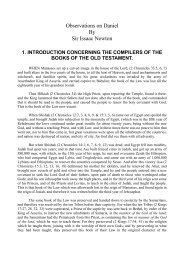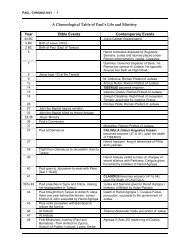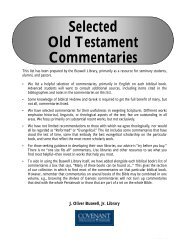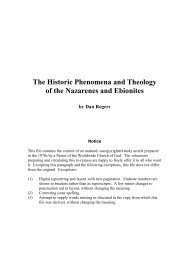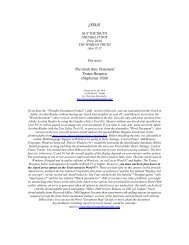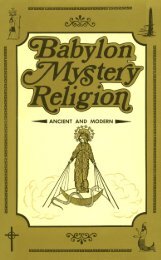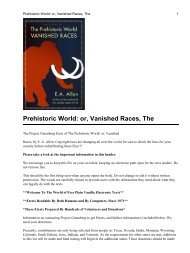Legends of the Shawangunk2 JR.pdf - Friends of the Sabbath ...
Legends of the Shawangunk2 JR.pdf - Friends of the Sabbath ...
Legends of the Shawangunk2 JR.pdf - Friends of the Sabbath ...
Create successful ePaper yourself
Turn your PDF publications into a flip-book with our unique Google optimized e-Paper software.
12 <strong>Legends</strong> <strong>of</strong> <strong>the</strong> Shawangunk.<br />
guinary. Without a moment’s warning, in <strong>the</strong> silent, unguarded hours <strong>of</strong> slumber, <strong>the</strong><br />
settler’s home would be invaded with terrific war-whoop and murderous tomahawk, and<br />
<strong>the</strong> whole family massacred or carried away into captivity.<br />
It is to be observed that <strong>the</strong> difficulties between <strong>the</strong> Delaware Indians and <strong>the</strong>ir white<br />
neighbors, which caused so much bloodshed on both sides, originated mainly from<br />
misunderstandings in regard to lands. The natives claimed, and not without reason, that<br />
<strong>the</strong>y were cheated in <strong>the</strong>ir transactions with <strong>the</strong> Dutch; that <strong>the</strong> latter assumed possession<br />
<strong>of</strong> more land than was sold to <strong>the</strong>m; and that boundaries and lines were altered, and<br />
always in favor <strong>of</strong> <strong>the</strong> whites. It cannot be denied that <strong>the</strong> Indians were not always paid<br />
<strong>the</strong> full stipulated purchase price, and were overreached by <strong>the</strong>ir more wily pale faces in<br />
various reprehensible ways.<br />
Lossing, in his “Field Book <strong>of</strong> <strong>the</strong> Revolution,” gives an instance in point. The<br />
natives had conveyed a territory to <strong>the</strong> “Proprietors <strong>of</strong> Pennsylvania,” <strong>the</strong> boundaries <strong>of</strong><br />
which were to extend a certain distance on <strong>the</strong> Delaware or “Great Fishkill” river, and as<br />
far back, in a northwest direction, as a man could travel in a day and a half. The Indians<br />
intended <strong>the</strong> depth <strong>of</strong> <strong>the</strong> tract should be about fifty miles, <strong>the</strong> distance a man would<br />
ordinarily walk in <strong>the</strong> specified time. But <strong>the</strong> purchasers employed <strong>the</strong> best pedestrians<br />
in <strong>the</strong> colonies, who did not stop by <strong>the</strong> way even to eat while running <strong>the</strong> line; <strong>the</strong><br />
expiration <strong>of</strong> <strong>the</strong> day and a half found <strong>the</strong>m eighty-five miles in <strong>the</strong> interior! The Indians<br />
boldly charged <strong>the</strong>m with deception and dishonesty.<br />
The “Proprietors” claimed that <strong>the</strong>y had become <strong>the</strong> owners <strong>of</strong> <strong>the</strong> lands within <strong>the</strong><br />
Forks <strong>of</strong> <strong>the</strong> Delaware river, by a regular form <strong>of</strong> conveyance, and that <strong>the</strong> Indians had<br />
been fully paid for <strong>the</strong>m. The Delawares, on <strong>the</strong> o<strong>the</strong>r hand, denied <strong>the</strong> validity <strong>of</strong> <strong>the</strong><br />
sale, and asserted that <strong>the</strong>y had never received a stipulated consideration. The case was,<br />
in 1742, laid before <strong>the</strong> Six Nations for arbitration, who, after hearing both sides, decided<br />
that <strong>the</strong> disputed territory could not be sold by <strong>the</strong> Delawares, as <strong>the</strong>y were a conquered<br />
people, who had lost <strong>the</strong>ir right in <strong>the</strong> soil; that if <strong>the</strong> lands did not belong to <strong>the</strong> white<br />
people, it was <strong>the</strong> property <strong>of</strong> <strong>the</strong> Six Nations. With two such rivals for claimants, as <strong>the</strong><br />
scheming whites and <strong>the</strong> dreaded Iroquois, <strong>the</strong> Delawares were fain obliged to forego<br />
<strong>the</strong>ir claim to <strong>the</strong> disputed territory. Some years ago a quantity <strong>of</strong> old spurious coin was<br />
dug up near Otisville, on <strong>the</strong> line <strong>of</strong> <strong>the</strong> Erie railroad. It was so clumsily executed as to<br />
preclude <strong>the</strong> supposition that it was <strong>the</strong> work <strong>of</strong> a gang <strong>of</strong> counterfeiters. The more<br />
reasonable <strong>the</strong>ory is that it was intended to be used to cheat <strong>the</strong> Indians as <strong>the</strong>y were not<br />
<strong>the</strong> best judges <strong>of</strong> money.<br />
Such treatment ruffled <strong>the</strong> tempers <strong>of</strong> <strong>the</strong> Delawares, and predisposed <strong>the</strong>m to make<br />
o<strong>the</strong>r complaints. They declared that <strong>the</strong> whites had spoiled <strong>the</strong>ir hunting-grounds; that<br />
<strong>the</strong>y had destroyed <strong>the</strong> deer with iron traps; and that <strong>the</strong> traders <strong>of</strong> Minisink always made<br />
<strong>the</strong> Indians drunk when <strong>the</strong>y took <strong>the</strong>ir peltries <strong>the</strong>re, and cheated <strong>the</strong>m while <strong>the</strong>y were<br />
in that condition. The period



